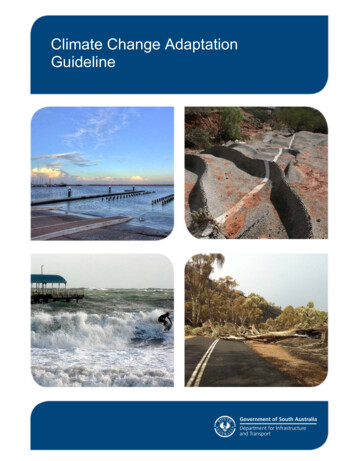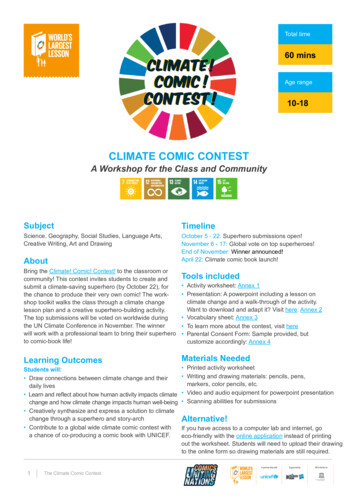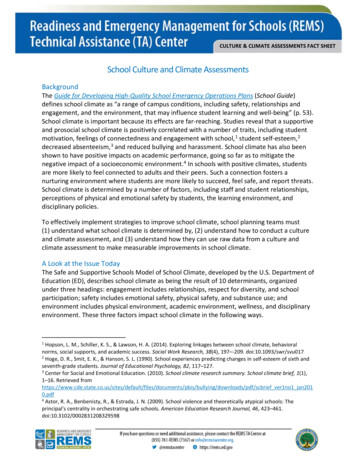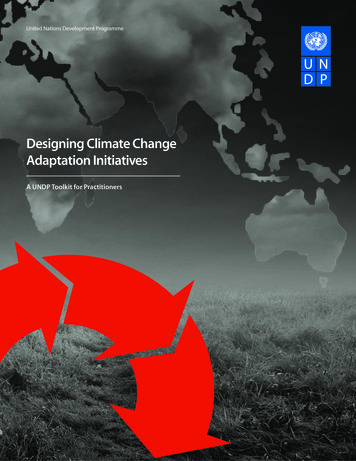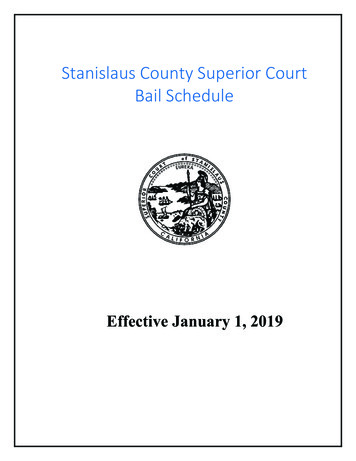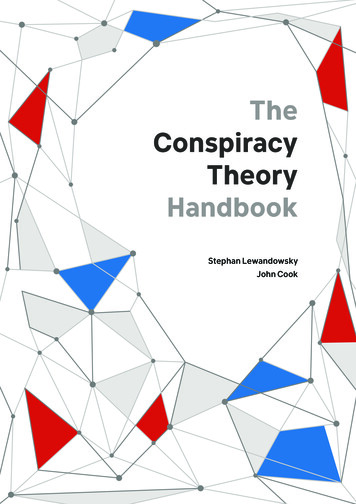
Transcription
TheConspiracyTheoryHandbookStephan LewandowskyJohn Cook
Written by:Stephan Lewandowsky, School of Psychological Science, University of Bristol,School of Psychological Science, University of Western Australia, andCSIRO Oceans and Atmosphere, Hobart, Tasmania, AustraliaJohn Cook, Center for Climate Change Communication, George Mason UniversityFirst published in March 2020.For more information, visit http://sks.to/conspiracyGraphic design: Wendy CookWith thanks to the COST Action COMPACT (Comparative Analysis of Conspiracy Theories).Cite as:Lewandowsky, S., & Cook, J. (2020). The Conspiracy Theory Handbook.Available at http://sks.to/conspiracy2The Conspiracy Theory Handbook
Distinguishing between real conspiraciesand conspiracy theoriesReal conspiracies do exist. Volkswagen conspired to cheat emissions testsfor their diesel engines. The U.S. National Security Agency secretly spied oncivilian internet users. The tobacco industry deceived the public about theharmful health effects of smoking. We know about these conspiracies throughinternal industry documents, government investigations, or whistleblowers.Conspiracy theories, by contrast, tend to persist for a long time even whenthere is no decisive evidence for them. Those conspiracy theories are basedon a variety of thinking patterns that are known to be unreliable tools fortracking reality. Typically, conspiracy theories are not supported by evidencethat withstands scrutiny but this doesn’t stop them from blossoming. Forexample, the widespread belief that the 9/11 terrorist attacks were an “insidejob” has persisted for many years after the event.1 Decades after the fact, avast majority of Americans believe that the government covered up the truthabout the JFK assassination.2Conspiracy theories damage society in a number of ways. For example,exposure to conspiracy theories decreases people’s intentions to engagein politics or to reduce their carbon footprint.3 In order to minimise theseharmful effects, The Conspiracy Theory Handbook helps you understandwhy conspiracy theories are so popular, explains how to identify thetraits of conspiratorial thinking, and lists effective debunking strategies.Typically,conspiracytheories arenot supportedby evidencethat withstandsscrutiny butthis doesn’tstop them fromblossoming.Conventional vs. Conspiratorial ThinkingActual conspiracies do exist but theyare rarely discovered through themethods of conspiracy theorists.Rather, real conspiracies getdiscovered through conventionalthinking—healthy skepticism of officialaccounts while carefully consideringavailable evidence and beingcommitted to internal consistency.4In contrast, conspiratorial thinking ischaracterized by being hyperskepticalof all information that does not fit thetheory, over-interpreting evidencethat supports a preferred theory, andinconsistency.Conventional ThinkingConspiratorial ThinkingHealthy skepticismOverriding suspicionResponsive to EvidenceOver-interpreting evidenceStrives for CoherenceContradictoryActual conspiracyImagined conspiracyThe Conspiracy Theory Handbook3
Why are conspiracy theories popular?A number of factors can contribute to people believing and sharing conspiracy theories.5People whofeel powerlessor vulnerableare more likelyto endorseand spreadconspiracytheories.Feeling of powerlessnessCoping with threatsPeople who feel powerless orvulnerable are more likely toendorse and spread conspiracytheories.6 This is seen inonline forums where people’sperceived level of threat isstrongly linked to proposingconspiracy theories.7Conspiracy theories allow peopleto cope with threatening eventsby focusing blame on a set ofconspirators.8 People find it difficult toaccept that “big” events (e.g., the deathof Princess Diana) can have an ordinarycause (driving while intoxicated). AExplaining unlikely eventsFor the same reason, peopletend to propose conspiratorialexplanations for events thatare highly unlikely.10 Conspiracytheories act as a copingmechanism to help peoplehandle uncertainty.conspiracy theory satisfies the needfor a “big” event to have a big cause,such as a conspiracy involving MI5 toassassinate Princess Diana.9Disputing mainstream politicsConspiracy theories are used to disputemainstream political interpretations.11Conspiratorial groups often use suchnarratives to claim minority status.Social media amplifies conspiracy theorizingSocial media has created a world in which any individual can potentially reach as many people as mainstreammedia.12 The lack of traditional gate-keepers is one reason why misinformation spreads farther and faster onlinethan true information13, often propelled by fake accounts or “bots”14. Likewise, consumers of conspiracy theorieshave been found to be more prone to “like” and share conspiracist posts on Facebook.15 A recent analysis oftweets about the Zika virus found that the number of propagators of conspiracy theories was more than doublethat of debunkers of those theories.164The Conspiracy Theory Handbook
How conspiracy theories do damageMere exposure to a conspiracy theory may have adverse consequences, even among people who don’tsubscribe to the conspiracy theory.3, 17, 18, 19, 20, 21 To illustrate, exposure to a conspiracy theory about the politicalmanipulation of unemployment data reduced trust in government services and institutions, including thoseunconnected to the conspiratorial allegations, such as local schools or the Food and Drug Administration.17Tactical conspiracy theoriesConspiracy theories aren’t always the result of genuinely held false beliefs.They can be intentionally constructed or amplified for strategic, politicalreasons. For example, there is evidence that the Russian governmentrecently contributed to the spread of various political conspiracy theories inthe West.22, 23Conspiracytheories maybe deployedas a rhetoricalConspiracy theories may be deployed as a rhetorical tool to escapeinconvenient conclusions. The rhetoric of climate denial is filled withincoherence, such as the simultaneous claims that temperature cannot bemeasured accurately but global temperatures have declined.24 Incoherenceis one attribute of conspiratorial thinking, but it does not follow that climatedenial is irrational—on the contrary, denialist rhetoric is an effective politicalstrategy to delay climate action by undermining people’s perception of thestrength of scientific evidence.tool to escapeinconvenientconclusions.In confirmation, people selectively appeal to a conspiracy among scientiststo explain away a scientific consensus when their political ideology compelsthem to do so—but not when the scientific consensus is of no relevance totheir politics.25Climate denial and conspiratorial thinking40Percentage of RespondentsRejecting the scientific consensus thathumans are causing global warmingis often the result of conspiratorialthinking rather than a careful weighingof scientific evidence.26 When climatedeniers are presented with informationabout climate change, their mostcommon response is conspiratorial innature.27 However, climate denial isn’tjust associated with climate-themedconspiracy theories—rather, people whodeny climate science are more likely toendorse conspiracy theories in othertopics as well.28Response to Global Warmingby climate change deniers3020100It’sNaturalHypeThe Conspiracy Theory h & Leiserowitz, 20125
CONSPIR: The seven traits of conspiratorial thinkingThere are seven traits of conspiratorial thinking 29, summarized (and more easily remembered) with theacronym ariousIntentSomethingMust Be WrongPersecutedVictimImmune nspiracy theorists can simultaneously believe in ideas that are mutually contradictory.For example, believing the theory that Princess Diana was murdered but also believingthat she faked her own death.30 This is because the theorists’ commitment to disbelievingthe “official“ account is so absolute, it doesn’t matter if their belief system is incoherent.Overriding suspicionConspiratorial thinking involves a nihilistic degree of skepticism towards the officialaccount.31 This extreme degree of suspicion prevents belief in anything that doesn’t fitinto the conspiracy theory.Nefarious intentThe motivations behind any presumed conspiracy are invariably assumed to benefarious.31 Conspiracy theories never propose that the presumed conspirators havebenign motivations.6The Conspiracy Theory Handbook
Something must be wrongAlthough conspiracy theorists may occasionally abandon specific ideas when theybecome untenable, those revisions don’t change their overall conclusion that “somethingmust be wrong” and the official account is based on deception.24, 30Persecuted victimConspiracy theorists perceive and present themselves as the victim of organizedpersecution.29 At the same time, they see themselves as brave antagonists takingon the villainous conspirators. Conspiratorial thinking involves a self-perception ofsimultaneously being a victim and a hero.Immune to evidenceConspiracy theories are inherently self-sealing—evidence that counters a theory isre-interpreted as originating from the conspiracy.31, 32, 33 This reflects the belief that thestronger the evidence against a conspiracy (e.g., the FBI exonerating a politician fromallegations of misusing a personal email server), the more the conspirators must wantpeople to believe their version of events (e.g., the FBI was part of the conspiracy toprotect that politician).Re-interpreting randomnessThe overriding suspicion found in conspiratorial thinking frequently results in the beliefthat nothing occurs by accident.34 Small random events, such as intact windows in thePentagon after the 9/11 attacks, are re-interpreted as being caused by the conspiracy(because if an airliner had hit the Pentagon, then all windows would have shattered 35) andare woven into a broader, interconnected pattern.The self-sealing nature of conspiracy theories means that any evidence disproving a theorymay be interpreted as further evidence for the conspiracy. This means that communicationefforts need to clearly differentiate between different target audiences. If conspiracytheorists re-interpret evidence to mean the opposite, then they require a different strategy tothose who value evidence. The following pages look first at communication strategies for thegeneral public, then for conspiracy theorists specifically.The Conspiracy Theory Handbook7
Protecting the public against conspiracy theoriesReducing the spread of conspiracy theoriesAn ounce of prevention is worth a pound of cure. Efforts shouldtherefore focus on protecting the public from exposure tothose theories, by inhibiting or slowing the spread of conspiracytheories. For example, sharing of conspiratorial climate-denialposts on Facebook was reduced by a simple intervention thatencouraged people to ask four questions about material beforesharing it: 36Do I recognize the news organization that posted the story?Does the information in the post seem believable?Is the post written in a style that I expect from a professionalnews organization?Is the post politically motivated?When efforts to contain the spread of a conspiracy fail,communicators must resort to strategies that reduce the impactof conspiracy theories.PrebunkingIf people aremade awareof the flawedreasoning foundin conspiracytheories, theymay becomeless vulnerableto such theories.8If people are preemptively made aware that they might be misled,they can develop resilience to conspiratorial messages. This processis known as inoculation or prebunking. There are two elements to aninoculation: an explicit warning of an impending threat of being misled,and refutation of the misinformation’s arguments. Prebunkings of antivaccination conspiracy theories have been found to be more effectivethan debunking.37Fact-based and logic-based inoculations have both been successful inprebunking a 9/11 conspiracy.38 This indicates some promise in logicbased prebunking, given the seven tell-tale traits of conspiratorialthinking (remember CONSPIR?). If people are made aware of the flawedreasoning found in conspiracy theories, they may become less vulnerableto such theories.The Conspiracy Theory Handbook
DebunkingThere are various ways to debunk conspiracy theories, some of which have been shown to be effective withpeople who are unlikely to endorse conspiracy theories, such as university students or the general public.Fact-based debunkingsLogic-based debunkingFact-based debunkings show that the conspiracytheory is false by communicating accurateinformation. This approach has been shown to beeffective in debunking the “birther” conspiracy whichholds that President Obama was born outside theU.S.21 as well as conspiracy theories relating to thePalestinian exodus when Israel was established.39Logic-based debunkings explain themisleading techniques or flawed reasoningemployed in conspiracy theories. Explainingthe logical fallacies in anti-vaccinationconspiracies has been found to be just aseffective as a fact-based debunking: Forexample, pointing out that much vaccinationresearch has been conducted by independent,publically-funded scientists can defangSource-based and empathy-based debunkingSource-based debunking attempts to reduce thecredibility of conspiracy theorists whereas empathybased debunkings compassionately call attention tothe targets of conspiracy theories. A source-baseddebunking that ridiculed believers of lizard men wasfound to be as effective as a fact-based debunking.In contrast, an empathy-based debunking of antiSemitic conspiracy theories that argued that Jewstoday face similar persecution as early Christians wasunsuccessful.41conspiracy theories about the pharmaceuticalindustry.40Links to fact checkersLinks to a fact-checker website from asimulated Facebook feed, whether via anautomatic algorithmic presentation or usergenerated corrections, effectively rebutted aconspiracy that the Zika virus was spread bygenetically-modified mosquitoes.42Empowering peopleConspiracy thinking is associated with feelings of reduced control and perceived threat.6, 7 When people feel likethey have lost control of a situation, their conspiracist tendencies increase.43 But the opposite also applies. Whenpeople feel empowered, they are more resilient to conspiracy theories.There are several ways to “cognitively empower” people, such as encouraging them to think analytically ratherthan relying on intuition.44 If people’s sense of control is primed (e.g., by recalling an event from their lives thatthey had control over), then they are less likely to endorse conspiracy theories.45 Citizens’ general feeling ofempowerment can be instilled by ensuring that societal decisions, for example by government, are perceivedto follow procedural justice principles.46 Procedural justice is perceived when authorities are believed to usefair decision-making procedures. People accept unfavourable outcomes from a decision if they believe thatprocedural fairness has been followed.47, 48The Conspiracy Theory Handbook9
How to talk to a conspiracy theoristWhile debunking conspiracy theories can be effective with the general public, it is much more challenging withpeople who believe the conspiracy theories. Rather than basing their beliefs on external evidence, conspiracytheorists’ belief system speaks mainly to itself, and each belief serves as evidence for every other belief.49As a consequence, when conspiracy theorists encounter debunkings on Facebook, they end up commentingand liking conspiracist content within their echo chambers even more—debunking enhanced conspiratorialinteractions.50Conspiracy theorists also have an outsized influence despite their small numbers. An analysis of over 2 millioncomments on the subreddit site r/conspiracy found that while only 5% of posters exhibited conspiratorialthinking, they were responsible for 64% of all comments. The most active author wrote 896,337 words, twice thelength of the Lord of the Rings trilogy! 51Conspiracy theories are an inevitable ingredient of political extremism. 52, 53 Research into deradicalizationtherefore provides useful insights into how to potentially reach conspiracy theorists.Trusted messengersShow empathyCounter-messages created by formermembers of an extremist community(“exiters”) are evaluated more positively andremembered longer than messages from othersources.54Approaches should be empathic and seek tobuild understanding with the other party. Becausethe goal is to develop the conspiracy theorist’sopen-mindedness, communicators must lead byexample.55Affirm critical thinkingAvoid ridiculeConspiracy theorists perceive themselves ascritical thinkers who are not fooled by an officialaccount. This perception can be capitalized onby affirming the value of critical thinking but thenredirect this approach towards a more criticalanalysis of the conspiracy theory.56Aggressively deconstructing or ridiculinga conspiracy theory, or focusing on“winning” an argument, runs the risk of beingautomatically rejected.54 Note, however, thatridicule has been shown to work with generalaudiences.41Final word of cautionAnalyze what is being targeted before attempting a debunk. U.S. Government attempts to debunk “conspiracytheories” have repeatedly backfired in predominantly Muslim countries. One example is the failed attemptto blame the absence of Weapons of Mass Destruction in Iraq after the invasion of 2003 on Iraq’s historyof concealment. A more productive approach would have been to focus on the American inflation of poorintelligence.57It’s also important to remember that real conspiracies do exist. But the traits of conspiratorial thinking(CONSPIR) are not a productive way to uncover actual conspiracies. Rather, conventional thinking that valueshealthy skepticism, evidence, and consistency are necessary ingredients to uncovering real attempts todeceive the public.10The Conspiracy Theory Handbook
5262728Laine, E. E., & Parakkal, R. (2017). National security, personal insecurity,and political conspiracies: The persistence of Americans’ beliefs in 9/11conspiracy theories. IUP Journal of International Relations, 11(3), 16–41.CBS poll (2009). cylives/Jolley, D., & Douglas, K. M. (2013). The social consequences of conspiracism:Exposure to conspiracy theories decreases intentions to engage in politicsand to reduce one’s carbon footprint. British Journal of Psychology, 105,35–56. doi:10.1111/bjop.12018Lewandowsky, S., Lloyd, E. A., & Brophy, S. (2018). When THUNCing Trumpsthinking: What distant alternative worlds can tell us about the real world.Argumenta, 3, 217–231. doi:10.23811/52.arg2017.lew.llo.broDouglas, K., Sutton, R., Cichocka, A., Ang, J., Deravi, F., Uscinski, J., &Nefes, T. (2019). Why do people adopt conspiracy theories, how are theycommunicated, and what are their risks? Centre for Research; Evidence onSecurity Threats. Retrieved from heories-douglas-full-report/Uscinski, J. E., & Parent, J. M. (2014). American conspiracy theories. Oxford,UK: Oxford University Press.Nefes, T. S. (2014). Rationale of conspiracy theorizing: Who shot thepresident Chen Shui-bian? Rationality and Society, 26, 373–394.doi:10.1177/1043463113519069Franks, B., Bangerter, A., & Bauer, M. W. (2013). Conspiracy theories asquasi-religious mentality: An integrated account from cognitive science,social representations theory, and frame theory. Frontiers in Psychology, 4.doi:10.3389/fpsyg.2013.00424Leman, P. J., & Cinnirella, M. (2007). A major event has a major cause: Evidencefor the role of heuristics in reasoning about conspiracy theories. SocialPsychological Review, 9, 18–28.Kovic, M., & Füchslin, T. (2018). Probability and conspiratorial thinking. AppliedCognitive Psychology, 32, 390–400. doi:10.1002/acp.3408Sapountzis, A., & Condor, S. (2013). Conspiracy accounts as intergrouptheories: Challenging dominant understandings of social power and politicallegitimacy. Political Psychology, 34, 731–752. doi:10.1111/pops.12015Allcott, H., & Gentzkow, M. (2017). Social media and fake news in the 2016election. Journal of Economic Perspectives, 31, 211–36. doi:10.1257/jep.31.2.211Vosoughi, S., Roy, D., & Aral, S. (2018). The spread of true and false news online.Science, 359, 1146–1151. doi:10.1126/science.aap9559Shao, C., Ciampaglia, G. L., Varol, O., Yang, K.-C., Flammini, A., & Menczer,F. (2018). The spread of low-credibility content by social bots. NatureCommunications, 9, 4787. doi:10.1038/s41467-018-06930-7Bessi, A., Coletto, M., Devidescu, G. A., Scala, A., Caldarelli, G., &Quattrociocchi, W. (2015). Science vs conspiracy: Collective narrativesin the age of misinformation. PLOS ONE, 10, e0118093. doi:10.1371/journal.pone.0118093Wood, M. J. (2018). Propagating and debunking conspiracy theories on Twitterduring the 2015–2016 Zika virus outbreak. Cyberpsychology, Behavior, andSocial Networking, 21, 485–490. doi:10.1089/cyber.2017.0669Einstein, K. L., & Glick, D. M. (2015). Do I think BLS data are BS? Theconsequences of conspiracy theories. Political Behavior, 37, 679–701.doi:10.1007/s11109-014-9287-zJolley, D., Meleady, R., & Douglas, K. M. (2019). Exposure to intergroupconspiracy theories promotes prejudice which spreads across groups. BritishJournal of Psychology. doi:10.1111/bjop.12385Raab, M. H., Auer, N., Ortlieb, S. A., & Carbon, C.-C. (2013). The Sarrazin effect:The presence of absurd statements in conspiracy theories makes canonicalinformation less plausible. Frontiers in Psychology, 4, 453. doi:10.3389/fpsyg.2013.00453van der Linden, S. (2015). The conspiracy-effect: Exposure to conspiracytheories (about global warming) decreases pro-social behavior and scienceacceptance. Personality and Individual Differences, 87, 171–173. doi:10.1016/j.paid.2015.07.045Warner, B. R., & Neville-Shepard, R. (2014). Echoes of a conspiracy: Birthers,truthers, and the cultivation of extremism. Communication Quarterly, 62, 1–17.doi:10.1080/01463373.2013.822407Avramov, K. (2018). By another way of deception: The use of conspiracytheories as a foreign policy tool in the arsenal of the hybrid warfare.Information & Security: An International Journal, 39, 151–161. doi:10.11610/isij.3913Yablokov, I. (2015). Conspiracy theories as a Russian public diplomacytool: The case of Russia Today (RT). Politics, 35, 301–315. doi:10.1111/14679256.12097Lewandowsky, S., Cook, J., & Lloyd, E. (2016). The “Alice in Wonderland”mechanics of the rejection of (climate) science: Simulating coherence byconspiracism. Synthese, 195, 175–196. doi:10.1007/s11229-016-1198-6Lewandowsky, S. (2020). Hannah Arendt and the contemporary socialconstruction of conspiracy theorists. Manuscript Submitted for Publication.Uscinski, J. E., Douglas, K. & Lewandowsky, S. (2017). Climate ChangeConspiracy Theories. Oxford Encyclopedia of Climate Change. doi:10.1093/acrefore/9780190228620.013.328Smith, N., & Leiserowitz, A. (2012). The rise of global warming skepticism:Exploring affective image associations in the United States over time. RiskAnalysis: An International Journal, 32(6), 1021-1032.Lewandowsky, S., Gignac, G. E., & Oberauer, K. (2013). The role of conspiracistideation and worldviews in predicting rejection of science. PLOS ONE, 8,e75637. doi:10.1371/journal.pone.007563729 Lewandowsky, S., Cook, J., Oberauer, K., Brophy, S., Lloyd, E. A., & Marriott, M.(2015). Recurrent fury: Conspiratorial discourse in the blogosphere triggeredby research on the role of conspiracist ideation in climate denial. Journal ofSocial and Political Psychology, 3, 142-178. doi:10.1093/eurpub/ckn13930 Wood, M. J., Douglas, K. M., & Sutton, R. M. (2012). Dead and alive: Beliefs incontradictory conspiracy theories. Social Psychological and PersonalityScience, 3, 767–773. doi:10.1177/194855061143478631 Keeley, B. L. (1999). Of conspiracy theories. The Journal of Philosophy, 96,109–126. doi:10.2307/256465932 Bale, J. M. (2007). Political paranoia v. political realism: On distinguishingbetween bogus conspiracy theories and genuine conspiratorial politics.Patterns of Prejudice, 41, 45–60. doi:10.1080/0031322060111875133 Sunstein, C. R., & Vermeule, A. (2009). Conspiracy theories: Causes andcures. Journal of Political Philosophy, 17, 202–227. doi:10.1111/j.14679760.2008.00325.x34 Barkun, M. (2003). A culture of conspiracy: Apocalyptic visions incontemporary America. Berkeley, CA: University of California Press.35 Swami, V., Chamorro-Premuzic, T., & Furnham, A. (2010). Unansweredquestions: A preliminary investigation of personality and individual differencepredictors of 9/11 conspiracist beliefs. Applied Cognitive Psychology, 24(6),749-761.36 Lutzke, L., Drummond, C., Slovic, P., & Árvai, J. (2019). Priming critical thinking:Simple interventions limit the influence of fake news about climate changeon Facebook. Global Environmental Change, 58, 101964. doi:10.1016/j.gloenvcha.2019.10196437 Jolley, D., & Douglas, K. M. (2017). Prevention is better than cure: Addressinganti-vaccine conspiracy theories. Journal of Applied Social Psychology, 47,459–469. doi:10.1111/jasp.1245338 Banas, J. A., & Miller, G. (2013). Inducing resistance to conspiracy theorypropaganda: Testing inoculation and metainoculation strategies. HumanCommunication Research, 39, 184–207. doi:10.1111/hcre.1200039 Nyhan, B., & Zeitzoff, T. (2017). Fighting the past: Perceptions of control,historical misperceptions, and corrective information in the Israeli-Palestinianconflict. Political Psychology, 39, 611-630. doi:10.1111/pops.1244940 Schmid, P., & Betsch, C. (2019). Effective strategies for rebutting sciencedenialism in public discussions. Nature Human Behavior 3, 931-939.doi:10.1038/s41562-019-0632-441 Orosz, G., Krekó, P., Paskuj, B., Tóth-Király, I., Böthe, B., & Roland-Lèvy, C.(2016). Changing conspiracy beliefs through rationality and ridiculing.Frontiers in Psychology, 7, 1525. doi:10.3389/fpsyg.2016.0152542 Bode, L., & Vraga, E. K. (2018). See something, say something: Correction ofglobal health misinformation on social media. Health Communication, 33,1131–1140. doi:10.1080/10410236.2017.133131243 Whitson, J. A., & Galinsky, A. D. (2008). Lacking control increases illusorypattern perception. Science, 322, 115–117. doi:10.1126/science.115984544 Swami, V., Voracek, M., Stieger, S., Tran, U. S., & Furnham, A. (2014). Analyticthinking reduces belief in conspiracy theories. Cognition, 133, 572–585.doi:10.1016/j.cognition.2014.08.00645 van Prooijen, J., & Acker, M. (2015). The influence of control on belief inconspiracy theories: Conceptual and applied extensions. Applied CognitivePsychology, 29, 753–761. doi:10.1002/acp.316146 van Prooijen, J.-W. (2018). Empowerment as a tool to reduce beliefin conspiracy theories. In Conspiracy theories and the people whobelieve them (pp. 432–442). Oxford University Press. doi:10.1093/oso/9780190844073.003.003047 Quintanilla, V. D., & Yontz, M. A. (2018). Human-Centered Civil Justice Design:Procedural Justice and Process Value Pluralism. Tulsa L. Rev., 54, 113.48 Tyler, T. R. (1987). Conditions leading to value-expressive effects in judgmentsof procedural justice: A test of four models. Journal of Personality and SocialPsychology, 52, 333–344. doi:10.1037/0022-3514.52.2.33349 Goertzel, T. (1994). Belief in conspiracy theories. Political Psychology, 15,731–742. doi:10.2307/379163050 Zollo, F., Bessi, A., Del Vicario, M., Scala, A., Caldarelli, G., Shekhtman, K.,Havlin, S., Quattrociocchi, W. (2017). Debunking in a world of tribes. PLOS ONE,12, e0181821. doi:10.1371/journal.pone.018182151 Klein, C., Clutton, P., & Polito, V. (2018). Topic modeling reveals distinctinterests within an online conspiracy forum. Frontiers in Psychology, 9.doi:10.3389/fpsyg.2018.0018952 Kundnani, A. (2012). Blind spot-security narratives and far-right violence.Security and Human Rights, 23, 129–146.53 van Prooijen, J.-W., Krouwel, A. P. M., & Pollet, T. V. (2015). Political extremismpredicts belief in conspiracy theories. Social Psychological and PersonalityScience, 6, 570-578. doi:10.1177/194855061456735654 Schmitt, J. B., Rieger, D., Ernst, J., & Roth, H.-J. (2018). Critical media literacyand islamist online propaganda: The feasibility, applicability and impact ofthree learning arrangements. International Journal of Conflict and Violence,12, 1–19. doi:10.4119/UNIBI/ijcv.64255 Ponsot, A. S., Autixier, C., & Madriaza, P. (2018). Factors facilitating thesuccessful implementation of a prevention of violent radicalizationintervention as identified by front-line practitioners. Journal forDeradicalization, (16), 1–33.56 Voogt, S. (2017). Countering far-right recruitment online: CAPE’s practitionerexperience. Journal of Policing, Intelligence and Counter Terrorism, 12,34–46. doi:10.1080/18335330.2016.121551057 Aistrope, T. (2016). Conspiracy theory and Americanforeign policy. Manchester University Press. doi:10.7228/manchester/9780719099199.001.0001The Conspiracy Theory Handbook11
Conspiracy theories attempt toexplain events as the secretiveplots of powerful people. Whileconspiracy theories are nottypically supported by evidence,this doesn’t stop them fromblossoming. Conspiracy theoriesdamage society in a number ofways. To help minimise theseharmful effects, The ConspiracyTheory Handbook explainswhy conspiracy theories areso popular, how to identify thetraits of conspiratorial thinking,and what are effective responsestrategies.
simultaneously being a victim and a hero. 8 The ac Handbook Protecting the public against conspiracy theories Reducing the spread of conspiracy theories An ounce of prevention is worth a pound of cure. Efforts should


